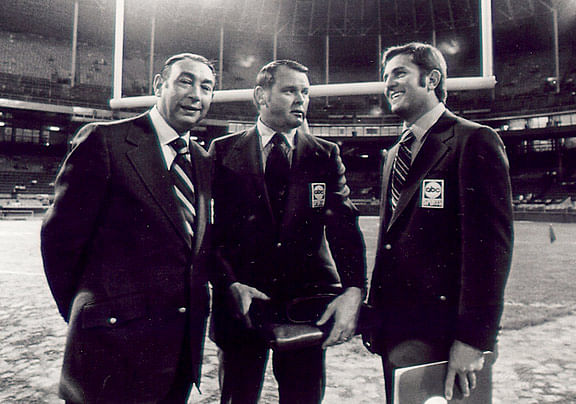
New York Jets history: 1970 season
Coming off a disappointing loss to the eventual Super Bowl IV-champion Kansas City Chiefs in the 1969 American Football League (AFL) Playoffs, the Jets sought to soar into a new era of football in 1970. (’69 Season Review)
Merger
As planned, the AFL merged with the NFL in 1970 to create a single 26-team league. The former AFL teams moved into the new three-division American Football Conference (AFC), while most of the old NFL teams were placed in the three-division National Football Conference (NFC). This basic alignment with East, Central, and West divisions in each conference lasted until the current four-division structure was implemented in 2002.
To balance out the conferences—the AFL had six fewer teams than the NFL—the NFL’s Pittsburgh Steelers, Cleveland Browns, and Baltimore Colts moved to the AFC.
Ironically, less than two years after falling to the Jets in Super Bowl III, the Colts would be joining the Jets in the AFC East.
1970 NFL Draft
The Jets endured mixed results in this draft. Their first-round pick (20th overall), DB Steve Tannen, played five serviceable seasons with Gang Green, but injuries hampered his effectiveness. Tannen’s best season came in 1972, when he tied for third in the league with seven interceptions.
New York made a solid second-round pick (46th overall) in TE Rich Caster. In eight seasons with the Jets, Caster was selected to three Pro Bowl teams.
The Jets also acquired talent via trade on this draft day. New York received FS WK Hicks from the Houston Oilers in exchange for a fifth-round draft choice (Murray Chass; New York Times; Jan. 28, 1970; p. 73). Hicks’ eight interceptions in 1970 would be tied for third most in the NFL.
Week One: At Cleveland Browns
In the debut of ABC-TV’s Monday Night Football, the Browns held off the Jets by 31-21.

Monday Night Football would remain an ABC fall staple for 35 years, until the program moved to its current home, ESPN, in 2006.
Ironically, against the New England Patriots on Dec. 26, 2005, the Jets lost the final ABC Monday Night Football contest by the same 31-21 final as they did in Cleveland. Talk about bookmarking!
QB Joe Namath (18-31; 298 yards; TD; 3 Int) was mediocre in this season opener, while RB Emerson Boozer (58 yards; 15 carries; 2 TD) and RB Matt Snell (108 yards; 16 carries) each enjoyed solid evenings. WR George Sauer (10 receptions; 172 yards; TD) also shined under the lights.
Gang Green was sloppy against the Browns. The visitors set a team record by amassing 161 penalty yards, and their 13 penalties tied a team record, which they had previously reached in the “Heidi Game” at Oakland on Nov. 17, 1968 (George Usher; Newsday; Sept. 18, 1978; back page).
The Jets’ current record for penalties in a single game, 20, was reached in a 27-20 win over the Buffalo Bills on Sept. 22, 2013 (Dennis Waszak, Jr; The Poughkeepsie Journal; Sept. 23, 2013; p. 5).
Week Two: At Boston Patriots
The Jets rebounded against the Patriots, evening their record with a 31-21 triumph (Dave Anderson; New York Times; Sept. 28, 1970; p. 58). Wow, what’s with that 31-21 score?
In the win, Namath (9 -20; 96 yards; TD) was efficient, as were Boozer (90 yards; 16 carries; TD) and Snell (85 yards; 26 carries; TD).
Week Three: At Buffalo Bills
Gang Green collapsed after building a 24-10 second quarter lead, and lost 34-31.
Special teams hindered thee Jets in the setback with K Jim Turner missing five of his six field goal attempts. Turner blamed himself for the loss, saying, “I had a bad day; the loss was my fault. I have no excuses. The wind was a problem, but the wind in Shea is a problem too, and I kick well there. No excuses (Anderson; Oct. 5, 1970; p. 76).”
Even worse than Turner’s performance, however, was Snell’s status. The reliable running back was lost for the year with a ruptured right Achilles tendon, and although he attempted to play in each of the next two seasons, his career was essentially over (Anderson; Oct. 5, 1970; p. 76).
Week Four: Miami Dolphins
Helped by an anemic Jets’ offense, Miami spoiled New York’s home opener at Shea Stadium, 20-6.
Namath (17-40; 240 yards; 3 Int) didn’t have much help. Snell was obviously inactive, and Sauer missed the final three quarters with a pulled leg muscle (Anderson; Oct. 11, 1970; p. 1).
This loss marked the first regular season game where the Jets were held without a touchdown since they failed to reach pay dirt in a 14-3 loss at Buffalo on Nov. 13, 1966. The Chiefs had kept the Jets out of the end zone in the previous year’s playoffs, though (Anderson; Oct. 11, 1970; p. 1).
Week Five: Baltimore Colts
In the first rematch of Super Bowl III, the Colts defeated the Jets, 29-22.
Namath (34-62; 397 yards; TD; 6 Int) struggled, but the six interceptions he threw soon became the least of the quarterback’s worries. During the game, Namath suffered a bruised thumb in addition to a “sprained wrist,” an injury that team orthopedist Dr. James A. Nicholas described as “minor.” Namath was concerned, though, saying, “It hurts pretty bad. It’s the first time I’ve ever been worried about an injury (Anderson; Oct. 19, 1970; p. 70).”
As it turned out, Namath, who hadn’t missed a game because of injury in his six-year career until this point, had good reason to be worried. A subsequent x-ray revealed that the quarterback’s wrist was actually fractured, and Namath missed the remainder of the season (Joseph Durso; New York Times; Oct. 21, 1970; p. 57).